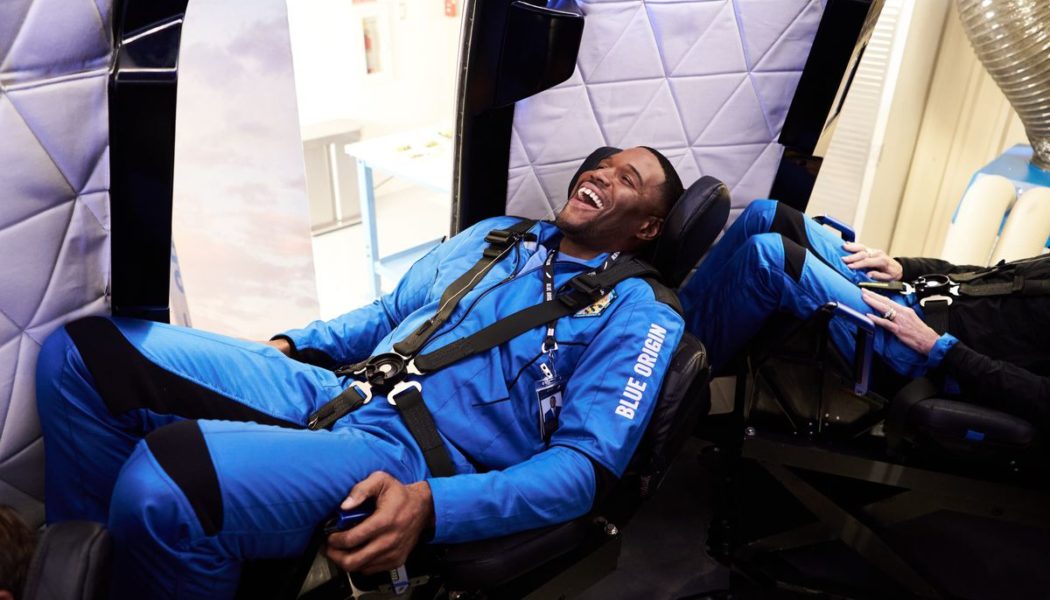This morning, Jeff Bezos’ spaceflight company Blue Origin is slated to launch another crew of customers to the edge of space and back. The crew cabin will be a little more crowded than usual: a total of six passengers will ride to space inside Blue Origin’s New Shepard tourist rocket, the largest group the company has ever sent up on one flight.
That makes this flight a bit unusual. The launch also comes after an FAA investigation into the safety of Blue Origin’s rockets came to an inconclusive resolution.
On board are a mixture of celebrity guests and paying spaceflight enthusiasts. Notably, Michael Strahan, a host for Good Morning America and former NFL rusher for the New York Giants, will be flying, along with Laura Shepard Churchley, the eldest daughter of Alan Shepard, who was the first American in space. Both are considered guests, so they did not pay for their seats. Flying with them are paying customers: Evan Dick, an investor, Lane Bess, the founder of Bess Ventures, and Bess’ son Cameron Bess. Dylan Taylor, a major investor in the spaceflight industry, will round out the group.
This will be Blue Origin’s third time launching people to the edge of space from the company’s test facility in Van Horn, Texas. For all three of these missions, Blue Origin has made sure to have some kind of star on board. The company’s first crewed mission carried Bezos, as well as legendary female aviator Wally Funk, while the second flight notably carried William Shatner, best known for playing Captain James T. Kirk on Star Trek. For those first two tourist flights, however, Blue Origin only flew crews of four. Videos from inside the crew cabin showed that the interior got somewhat crowded, even with such small complements of people. It’ll be interesting to see how a crew of six fares, which is the maximum number of people the capsule is supposed to hold.
:no_upscale()/cdn.vox-cdn.com/uploads/chorus_asset/file/23080220/blueorigin_ns19_strahanseatsmiling_l_3.jpg)
The flight comes just after the Federal Aviation Administration confirms that it closed an investigation into Blue Origin’s safety culture without finding any substantial issues. The FAA, which is responsible for issuing licenses for commercial rocket launches, started looking into the company in early October after 21 current and former employees at Blue Origin published an essay alleging a culture of rampant sexual harassment and safety concerns with the company’s rockets. The essay, penned by former Blue Origin head of employee communications Alexandra Abrams, argued that employees are too scared to speak about safety violations over fears of retaliation.
“In the opinion of an engineer who has signed on to this essay, ‘Blue Origin has been lucky that nothing has happened so far,’” the essay stated. “Many of this essay’s authors say they would not fly on a Blue Origin vehicle.”
When the essay came out, the FAA said it was “reviewing the information.” However, as CNN first reported on Friday and the FAA confirmed to The Verge, its investigation is now over. Steven Kulm, a public affairs specialist at the FAA, told The Verge that the FAA found “no specific safety issues” after investigating allegations made against the company’s human spaceflight program. When asked for comment, Linda Mills, the vice president for communications at Blue Origin, said, “The FAA statement is accurate.”
However, in an email obtained by The Verge, FAA representatives explained to Abrams that the agency was unable to conduct a thorough investigation because no additional engineering or safety experts from Blue Origin came forward to discuss issues at the company that were raised in Abrams’ letter. The emails show that FAA investigators put the burden on Abrams to convince her former colleagues to speak up. Abrams passed along key information to the investigators, including email exchanges between Blue Origin employees detailing concerns over capsule recovery operations and a memo crafted by a departing employee about safety concerns. She also got nearly three people to provide written statements, but the individuals ultimately backed out over fears of their identities being disclosed, Abrams tells The Verge. In an email to Abrams, the FAA noted that those who came forward could not be guaranteed protection because there are no statutes in place to protect whistleblowers at space companies.
A copy of the FAA’s email to Abrams, sent on December 6th, is below:
It has been several weeks since our last contact with you and although we know you did everything possible to try and persuade members of your group to come forward, no technical experts have reached out to us or provided any specific documentation regarding the safety allegations. We understand that there are no federal “whistleblower protection” statutes protecting employees of commercial space companies from retaliation resulting from reporting safety issues. This is in stark contrast to the extensive protections available to commercial aviation industry whistleblowers. We believe this was an enormous factor in our inability to pursue this investigation further.
Following a thorough review of the limited information provided, multiple discussions with you, and consulting the applicable law and regulations, the FAA could not investigate this matter in depth, and thus, could not substantiate the safety concerns described in the document you provided. No further actions can be recommended at this time.
Currently, the commercial space industry benefits from little federal oversight regarding safety, thanks to something called the US Commercial Space Launch Competitiveness Act passed in 2015. The law prohibits the FAA or other federal agencies from placing safety regulations on the commercial space industry until 2023. The impetus for the law was to allow a space industry that’s still in its infancy to continue to grow and innovate without “burdensome” regulations. That means when the FAA issues launch licenses, it is only responsible for making sure that a rocket launch will not harm uninvolved people or property on the ground. The agency cannot dictate rules for how commercial space companies should make their vehicles or operations safer. Commercial space tourists fly through “informed consent,” meaning they agree that the trip they are taking is inherently dangerous and risky.
After the original essay was published in October, the company stood by its culture. “Blue Origin has no tolerance for discrimination or harassment of any kind. We provide numerous avenues for employees, including a 24/7 anonymous hotline, and will promptly investigate any new claims of misconduct,” a Blue Origin spokesperson told The Verge in a statement.
To get passengers to the edge of space and back, Blue Origin relies on its New Shepard rocket, a reusable vehicle designed to launch upright from Earth and then land upright back on the ground again. Passengers ride on top of the vehicle inside a crew cabin with reclined seats and large windows. Once the rocket reaches a certain altitude, the cabin separates from the top of the rocket and enters space, allowing the riders to experience a few moments of weightlessness. Both the capsule and the rocket return to Earth; the rocket lands upright, while the capsule touches down gently using parachutes.
Typically, New Shepard reaches an altitude of roughly 62 miles up when it flies, which most consider to be above the boundary to space. When today’s passengers return to Earth, all of them should be awarded commercial astronaut wings by the FAA. These wings have historically been given to people who fly above 50 miles on a commercial spacecraft. However, the FAA announced this week that it will be ending this practice by the end of the year and will merely list all future commercial tourists and flyers who reach space on the agency’s website. That means this crew may be the last ones to ever get the wings.
Today’s New Shepard launch is slated for takeoff this morning at 9:45AM ET out of Blue Origin’s launch site in Van Horn. Blue Origin plans to begin live coverage 90 minutes ahead of launch.









